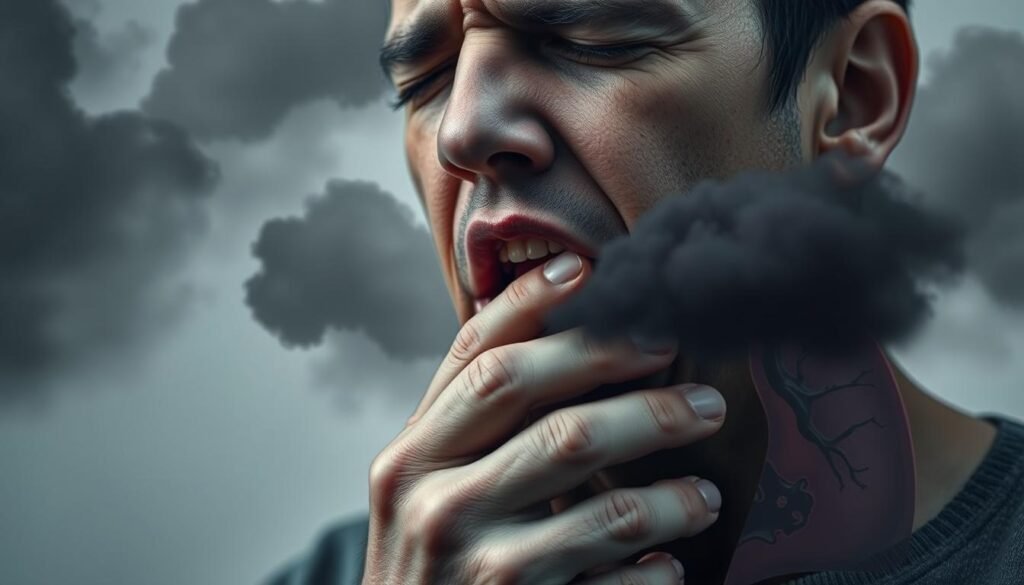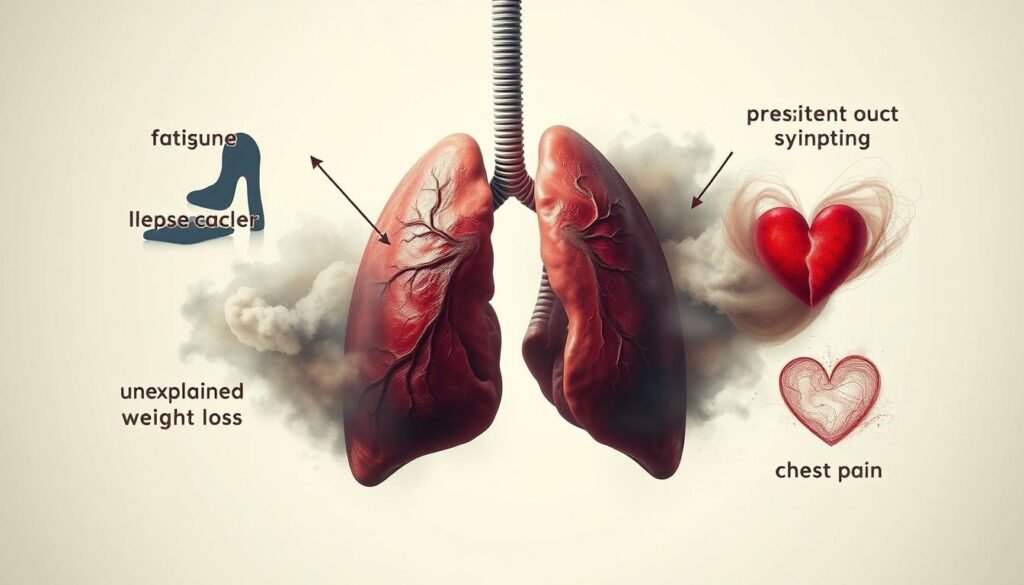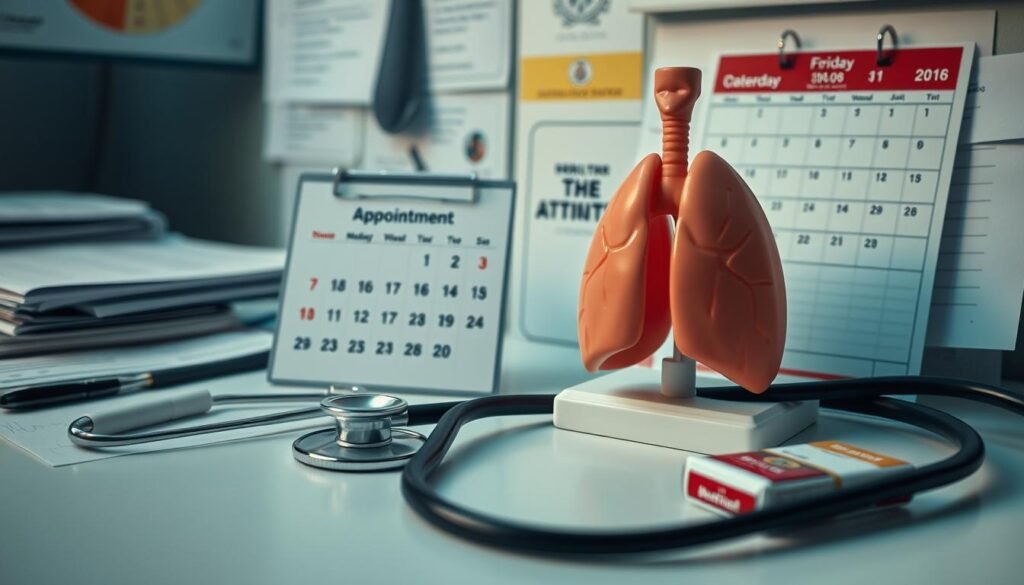Lung cancer causes almost 25% of all cancer deaths in the United States. Knowing the early signs and symptoms is crucial for lung cancer awareness. Early detection can greatly improve one’s chances of survival.
This piece will help you understand early signs of lung cancer and the importance of quick doctors’ visits. Knowing these signs can help you defend your health for a better outcome. We’ll look at common symptoms, the importance of early detection, and how screening plays a role.
Key Takeaways
- Lung cancer is responsible for nearly 25% of cancer-related deaths in the U.S.
- Understanding early signs and symptoms of lung cancer can improve prognosis.
- Timely medical consultation is crucial for effective treatment.
- Common symptoms of lung cancer include persistent coughing and chest pain.
- Lung cancer awareness is vital for early detection and health advocacy.
Understanding Lung Cancer
Lung cancer poses a major health challenge worldwide. It comes in two key forms. These are primary lung cancer, starting in the lungs, and secondary lung cancer, coming from other body parts. About 85% of lung cancer patients have non-small cell lung cancer (NSCLC). The rest have small cell lung cancer (SCLC). It’s vital to know the differences to understand lung cancer statistics.
NSCLC includes several subtypes like adenocarcinoma. This subtype often affects women and usually occurs in the lungs’ outer areas. Squamous cell carcinoma typically develops near the bronchus. Meanwhile, large cell carcinoma grows quickly. SCLC is known for its rapid spread and may cause serious health issues like hypercalcemia. This can lead to confusion and frequent urination.
Lung cancer is the top cause of cancer deaths for men and women. This is mainly because it’s often found too late. Most lung cancer in men is caused by smoking—about 90%. In women, it’s around 80%. Things like secondhand smoke and pollution also increase the risk. Work hazards like asbestos add to this risk as well.
Treatment strategies for what is lung cancer usually aim to control symptoms. They don’t often cure the disease. Treatments differ between NSCLC and SCLC. Knowing these facts helps with early detection. This is especially important for people between 50 and 80 who smoke.
| Type of Lung Cancer | Prevalence % | Common Treatments |
|---|---|---|
| Non-Small Cell Lung Cancer (NSCLC) | 85% | Surgery, chemotherapy, radiation, immunotherapy, targeted therapy |
| Small Cell Lung Cancer (SCLC) | 15% | Chemotherapy, radiation, surgery, immunotherapy |
Importance of Early Detection
Finding lung cancer early is key to treating it better and helping people live longer, healthier lives. In the US, lung cancer is the second most common cancer and the top cause of cancer death. Catching it early is essential because many don’t feel sick until the cancer is advanced.
Studies show routine chest x-rays don’t help people live longer. But, yearly checks with low-dose CT scans can find lung cancer early. This early detection means treatment can start sooner, improving chances of survival.
The American Cancer Society advises yearly LDCT screenings for those 50 to 80 years old who smoke or used to smoke a lot. Catching lung cancer early means treatment works better and is less complicated.
But, only 21% of lung cancers are found when the cancer hasn’t spread much. This fact shows how crucial it is to follow screening advice. Screening is for those healthy enough for treatment if needed. Making the decision to get screened should involve talking to your doctor.
| Screening Considerations | Details |
|---|---|
| Recommended Age Group | 50 to 80 years |
| Smoking History | 20-pack-year minimum |
| Type of Scan | Low-dose CT scan |
| Radiation Exposure | Low, more than chest x-ray but less than standard CT |
| Insurance Coverage | Medicare and many private plans |
| Health Requirements | Must be in fairly good health for treatment if diagnosed |
| Facility Requirements | Must be equipped for LDCT scanning |
Screening has risks like radiation and false positives, but the benefits of finding cancer early are too important. It leads to better chances of surviving and healthier lives.
Common Signs and Symptoms of Lung Cancer
Lung cancer is the top cause of cancer deaths in the US, impacting both genders. Recognizing common lung cancer symptoms boosts early detection chances. A persistent cough is often a major sign, usually lasting more than several weeks. About half of the people diagnosed show this symptom.
Some other significant lung cancer warning signs include:
- Chest pain, which may mean blockages in the airways.
- Unexplained weight loss, defined as losing more than 5% of body weight or 10 pounds in six months.
- Shortness of breath, especially if a tumor blocks major airways.
- Hoarseness or voice changes, which may indicate vocal cord pressure.
Remember, these symptoms can come from many conditions, so don’t ignore them. It’s best to see a doctor for a check-up. Knowing the common lung cancer symptoms early can help find the best treatment.
Signs and Symptoms of Lung Cancer
Spotting symptoms early can change outcomes for anyone with lung cancer. Everyone should watch for key signs. These include a cough that sticks around, pain in the chest, and feeling short of breath. Early notice of these signs can help catch the disease sooner.
Persistent Cough
A cough that won’t quit is often a first clue of lung cancer. This cough lingers for more than three weeks and gets worse as time goes by. Some might mistake it for a regular cold or flu and wait too long to see a doctor.
Chest Pain
Chest pain is common in lung cancer, especially when you take a deep breath, cough, or laugh. The pain’s intensity can vary, causing a lot of discomforts. It’s key to not ignore this pain because it could mean serious lung issues are present.
Shortness of Breath
Struggling to breathe might be due to lung cancer. It makes simple activities hard and hurts your life quality. If breathing becomes hard without a clear reason, see a doctor. This symptom is critical for spotting lung cancer early on.

| Symptom | Description |
|---|---|
| Persistent Cough | Does not go away after three weeks; often worsens. |
| Chest Pain | Coughing, laughing, or deep breathing can worsen discomfort. |
| Shortness of Breath | Impacts daily life; may indicate underlying lung issues. |
Types of Lung Cancer and Their Symptoms
Lung cancer includes different types, each with its own symptoms. Knowing these types is key for early detection and treatment. There are two main kinds: non-small cell lung cancer (NSCLC) and small cell lung cancer (SCLC). Each has different signs that help doctors and patients decide on the best care.
Non-Small Cell Lung Cancer (NSCLC)
Non-small cell lung cancer is the most common kind of lung cancer. It has a few subtypes, such as squamous cell carcinoma, adenocarcinoma, and large cell carcinoma. The symptoms of NSCLC tend to show up slowly. This slow onset can make patients wait before getting help.
Common NSCLC symptoms are:
- Persistent cough
- Shortness of breath
- Chest pain
- Fatigue and loss of appetite
- Unexplained weight loss
Knowing these symptoms can push for quicker doctor visits. Early detection greatly improves treatment success. For more on lung cancer types, see this resource.
Small Cell Lung Cancer (SCLC)
Small cell lung cancer is less common but grows quickly. It mainly affects heavy smokers. SCLC has signs like:
- Severe chest pain
- Shortness of breath
- Coughing up blood
- Fatigue and rapid weight loss
Being aware of these signs is crucial. SCLC moves fast, needing fast responses. Watching for these symptoms can lead to more effective treatments.
Less Common Symptoms to Watch For
Many know the common signs of lung cancer. But, several less common symptoms also need attention. Recognizing things like coughing up blood, feeling very tired, and other unusual signs can help find the disease early. This early detection can lead to better treatment results.
Coughing Up Blood
Seeing blood when you cough is a serious warning. It may mean the cancer in the lungs is growing. When you also have a lasting cough or pain in your chest, you should see a doctor right away.
Hoarseness
Hoarseness can happen if lung tumors press on nearby nerves. This condition is worrisome. It can mean a tumor is affecting the nerve that helps us speak. If ignored, it could lead to more problems.
Fatigue and Weight Loss
Lung cancer can make you feel very tired for many reasons, like not having enough red blood cells. Losing weight without trying is another common sign. Both of these symptoms can show the cancer might be at an advanced stage. They suggest seeing a doctor for more checks.

| Symptom | Description | Significance |
|---|---|---|
| Coughing Up Blood | Blood in sputum; may indicate tumor progression. | Indicates severe lung issues requiring immediate attention. |
| Hoarseness | Altered voice; potential nerve involvement. | Could suggest tumor pressure on vital nerves. |
| Fatigue and Weight Loss | Extreme tiredness and unexplained loss of weight. | May signify advanced cancer and body’s nutritional struggles. |
The Role of Lung Cancer Screening
Lung cancer screening is key for finding the disease early, especially in people at high risk. If you’re 50 or older and smoked a lot, getting checked is advised. Finding cancer early can greatly lower the chance of dying from it.
Screening is advised if you have a 20 pack-year history or quit in the past 15 years. The US Preventive Services Task Force recommends yearly screenings. They use low-dose CT scans for those 50 to 80 who meet the risk factors. This helps catch lung issues early, even before symptoms show up.
Doctors don’t all agree on when to stop screening. Screening may lead to more tests if something suspicious is found. This can change a person’s health future. Also, some lung cancers grow slowly and might not need quick action, which could cause overtreatment.
Screenings are key for spotting lung cancer early and can uncover other smoker-related health problems. While there are risks like false alarms and radiation, the benefits for those at high risk often outweigh these. Regular checks can increase the chances of beating the disease, showing why early detection is critical.
When to Seek Medical Advice
Knowing when to see a doctor for lung cancer is crucial. It can greatly improve your health outcomes. Early detection can significantly change treatment options and the overall success rate. If you have persistent symptoms, it’s important to listen to what your body is telling you.
Recognizing Warning Signs
Being aware of the signs of lung cancer can save lives. It’s important to keep an eye on specific symptoms:
- Persistent cough lasting more than three weeks
- Chest pain that doesn’t go away
- Coughing up blood
- Unexplained weight loss
- Shortness of breath
- Recurring respiratory infections
These symptoms could indicate other health conditions, but they need urgent attention. If you have any of these signs, you should quickly seek medical advice.
Importance of Medical Consultation
Getting medical advice early can lead to an earlier diagnosis of lung cancer. Many symptoms don’t show until the cancer is advanced. A timely chat with your doctor could lead to early treatment, greatly improving its effectiveness. Never delay consulting a doctor if you have persistent signs or new health changes.

For more details on symptoms and their meanings, readers can visit Healthline and Care Your Lungs.
Diagnosing Lung Cancer
Knowing how lung cancer is diagnosed is key for quick and effective treatment. The first steps usually involve tests that create pictures of the inside of the lungs. These images help find cancerous cells.
Imaging Tests
Imaging tests are very important for diagnosing lung cancer. It starts with a chest X-ray. This is the first test doctors use. If the X-ray shows something unusual, a CT scan is next. This scan gives a clearer picture of the lungs. For certain patients, a PET-CT scan might be needed. It finds active cancer cells, helping doctors decide on the best treatment.
If the CT scan suggests lung cancer might be present, a doctor might suggest a bronchoscopy. This is especially useful for problems in the chest’s center. An endobronchial ultrasound scan (EBUS) may also be done. It takes about 90 minutes and helps check lymph nodes for cancer spread. Sometimes, a percutaneous needle biopsy is used to get tissue samples from the lung.
Biopsy Procedures
Biopsies are crucial for confirming if it’s lung cancer. Doctors use methods like thoracoscopy and mediastinoscopy to get tissue samples. Biopsies are mostly safe, but sometimes they can cause problems. One issue could be a pneumothorax, where the lung leaks air and might need treatment.
The TNM system is used to stage lung cancer. It looks at tumor size, if lymph nodes are involved, and if the cancer has spread. Non-small-cell lung cancer stages are based on tumor size (T1-T4) and lymph node involvement (N1-N3). Small-cell lung cancer is put into two groups: limited or extensive disease. Knowing about these tests can help patients talk better with their doctors and improve their chances of successful treatment.
Treatment Options for Lung Cancer
Looking into lung cancer treatments can feel overwhelming because of the many options. There are different methods for differing patient needs. Each method targets specific cancer types and stages, offering personalized care.
Surgery
Surgery often involves taking out the tumor and nearby tissue. It’s usually the go-to for those with early-stage cancer. There are a few surgery types, depending on how far the cancer has spread:
- Wedge resection: Removing a small, wedge-shaped part of the lung.
- Segmental resection: Taking out a bigger lung section with the tumor.
- Lobectomy: Getting rid of an entire lung lobe.
- Pneumonectomy: Taking out one whole lung.
The timing and choice of surgery rely on the cancer stage and patient health.
Chemotherapy and Radiation
Chemotherapy and radiation are key for treating advanced lung cancer. Chemotherapy uses strong drugs to attack cancer cells. It’s given through an IV. It can be used before or after surgery to shrink or remove tumors.
Radiation kills cancer cells and shrinks tumors with high-energy beams. It’s used with chemotherapy and can be given before or after surgery. Stereotactic body radiotherapy is a focused treatment for certain lung cancers.
Sometimes, a mix of chemotherapy and radiation is used. This shows that lung cancer treatment is tailored to each person. Knowing these options helps patients and doctors make the best treatment plan.
Support and Resources for Patients
Receiving a lung cancer diagnosis can be overwhelming. But there are many resources available for lung cancer patient support. Organizations like CancerCare and the American Lung Association help patients through this journey.
The LUNGevity Lung Cancer Helpline, at 844-360-LUNG (5864), offers guidance and support. Besides, CancerCare provides financial help to families in need. This aid helps manage lung cancer symptoms better.
Support groups are essential for emotional support. CancerCare’s free groups, like the Lung Cancer Caregiver Support Group and the Lung Cancer Patient Support Group, build community. Here, patients can share experiences and learn coping strategies.
Educational resources also play a key role. CancerCare’s Connect Education Workshops feature oncology experts who share vital information. These workshops keep patients up-to-date on cancer treatments and innovations.
For logistical support, Magnolia Meals at Home delivers meals in certain areas. This service provides nutritious meals to families facing cancer, easing their burden.
CancerCare’s Coping Circle Workshops, led by oncology social workers, offer emotional support. These workshops, in English and Spanish, focus on emotional well-being and practical strategies for symptom management.
Lastly, the American Lung Association’s Lung HelpLine, available at 1-800-LUNG-USA (1-800-586-4872), offers information on lung health. Their extensive online Resource Library includes videos and downloadable content. It makes accessing lung cancer research updates easier for patients.
Conclusion
Raising awareness about lung cancer is very important. It helps improve outcomes for those with the disease. Catching symptoms early can greatly boost the success of treatment.
Even though lung cancer might not show many signs at first, being alert to any possible symptoms is key. This early awareness can lead to catching the disease sooner. That means better treatment options and outcomes.
Statistics show hard facts about lung cancer, highlighting the need for more awareness. Lung cancer is the top cancer killer. Yet, the chance of survival five years after diagnosis has doubled from 5% to 10%.
These facts show how knowing the symptoms and risk factors can save lives. Being informed lets people take control of their health.
It’s crucial to be proactive, especially for people at high risk. Understanding symptoms and getting regular checks are vital steps. For more detailed information on lung cancer, check out this comprehensive guide. It’s a great resource.